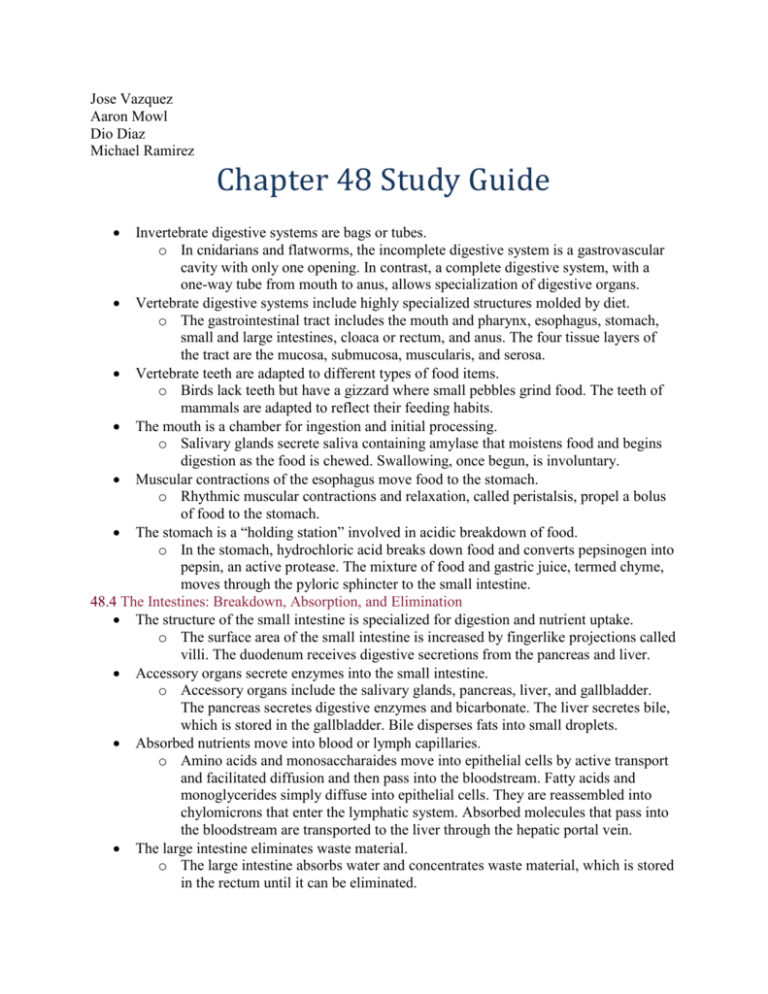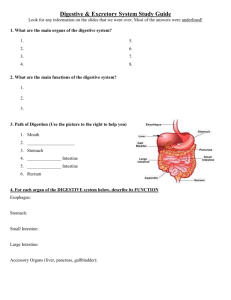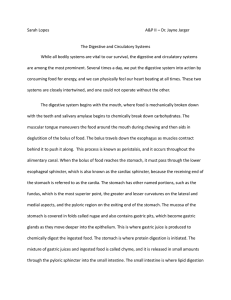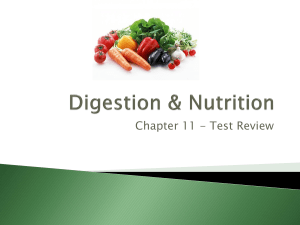Jose Vazquez - Cloudfront.net
advertisement

Jose Vazquez Aaron Mowl Dio Diaz Michael Ramirez Chapter 48 Study Guide Invertebrate digestive systems are bags or tubes. o In cnidarians and flatworms, the incomplete digestive system is a gastrovascular cavity with only one opening. In contrast, a complete digestive system, with a one-way tube from mouth to anus, allows specialization of digestive organs. Vertebrate digestive systems include highly specialized structures molded by diet. o The gastrointestinal tract includes the mouth and pharynx, esophagus, stomach, small and large intestines, cloaca or rectum, and anus. The four tissue layers of the tract are the mucosa, submucosa, muscularis, and serosa. Vertebrate teeth are adapted to different types of food items. o Birds lack teeth but have a gizzard where small pebbles grind food. The teeth of mammals are adapted to reflect their feeding habits. The mouth is a chamber for ingestion and initial processing. o Salivary glands secrete saliva containing amylase that moistens food and begins digestion as the food is chewed. Swallowing, once begun, is involuntary. Muscular contractions of the esophagus move food to the stomach. o Rhythmic muscular contractions and relaxation, called peristalsis, propel a bolus of food to the stomach. The stomach is a “holding station” involved in acidic breakdown of food. o In the stomach, hydrochloric acid breaks down food and converts pepsinogen into pepsin, an active protease. The mixture of food and gastric juice, termed chyme, moves through the pyloric sphincter to the small intestine. 48.4 The Intestines: Breakdown, Absorption, and Elimination The structure of the small intestine is specialized for digestion and nutrient uptake. o The surface area of the small intestine is increased by fingerlike projections called villi. The duodenum receives digestive secretions from the pancreas and liver. Accessory organs secrete enzymes into the small intestine. o Accessory organs include the salivary glands, pancreas, liver, and gallbladder. The pancreas secretes digestive enzymes and bicarbonate. The liver secretes bile, which is stored in the gallbladder. Bile disperses fats into small droplets. Absorbed nutrients move into blood or lymph capillaries. o Amino acids and monosaccharaides move into epithelial cells by active transport and facilitated diffusion and then pass into the bloodstream. Fatty acids and monoglycerides simply diffuse into epithelial cells. They are reassembled into chylomicrons that enter the lymphatic system. Absorbed molecules that pass into the bloodstream are transported to the liver through the hepatic portal vein. The large intestine eliminates waste material. o The large intestine absorbs water and concentrates waste material, which is stored in the rectum until it can be eliminated. Ruminants rechew regurgitated food. o The four-chambered stomach of ruminants consists of the rumen, reticulum, omasum, and abomasum. Food initially processed in the rumen is regurgitated for further chewing. Foregut fermentation has evolved convergently many times. o Enlarged foreguts have evolved in many species to provide a chamber for microbial fermentation. In some unrelated herbivores, identical changes in lysozyme have evolved. Other herbivores have alternative strategies for digestion. o In some herbivores, digestion of cellulose by microorganisms takes place in the cecum, located beyond the stomach. The activities of the gastrointestinal tract are coordinated by the nervous and endocrine systems. Duodenal hormones regulate passage of chyme into the duodenum. High fat content in the chyme stimulates the release of CCK and GIP; low chyme pH stimulates the release of secretin. In turn, CCK stimulates release of pancreatic enzymes and bile. Secretin stimulates release of bicarbonate. The liver modifies chemicals to maintain homeostasis. o The liver is involved in detoxification, regulation of steroid hormone levels, and production of proteins found in the blood plasma. Blood glucose concentration is maintained by the actions of insulin and glucagon. o Insulin lowers blood glucose and increases glycogen storage; glucagon increases blood glucose and utilization of glycogen. Exertion increases metabolic rate. o The basal metabolic rate is the minimum rate of energy consumption under resting conditions. Activity leads to an increase in the metabolic rate. Food intake is under neuroendocrine control. o Food intake is regulated by the hormones leptin and insulin, by enterogastrone, and by neuropeptides. Essential nutrients are those that the body cannot manufacture. o Essential nutrients are those that cannot be synthesized by animals. For humans, they are 13 vitamins, the essential amino acids, essential minerals, and certain fatty acids.











